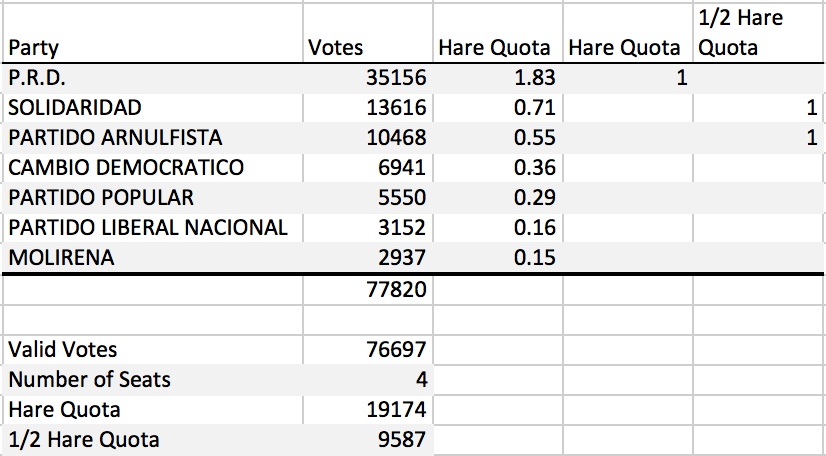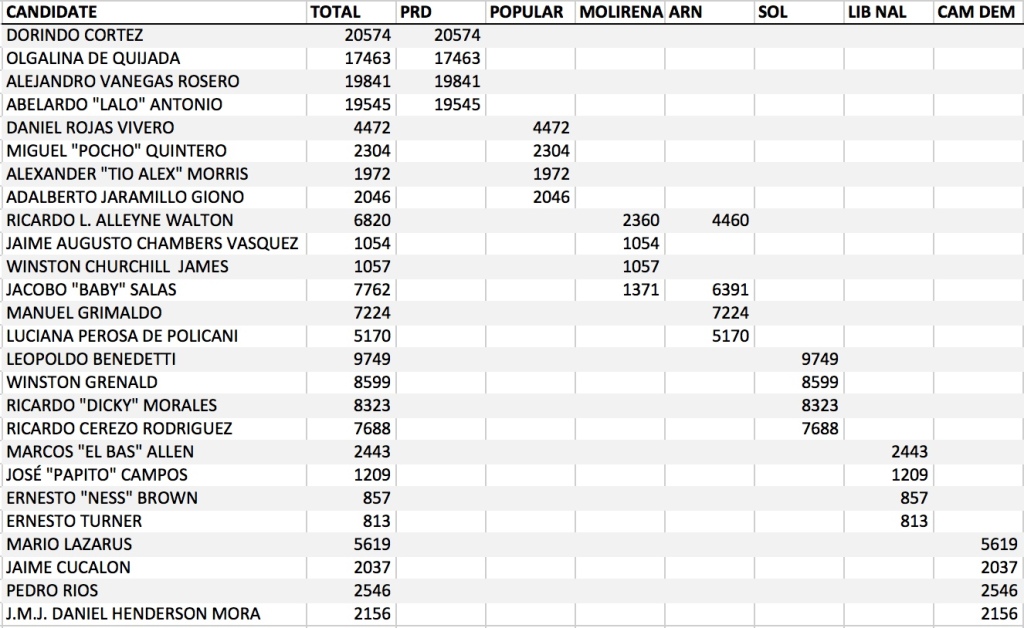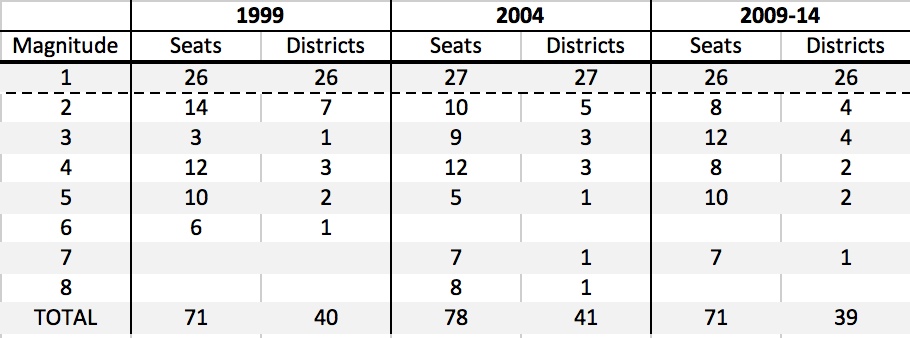Panama utilizes a Coexistance system to elect the National Assembly (Asamblea Nacional) with members elected by one electoral system from single-member constituencies and others elected by another electoral system from multimember constituencies. Finally, parties that win 5% of the vote but have not received any seats are entitled to a single mandate. Elections were held on the lines of the system described here in 1994, 1999, 2004, 2009, and 2014.
Single-Member Constituencies
In single-member constituencies, the candidate with the most votes wins election. Panama allows fusion, so different parties may nominate the same candidate with the candidate collecting votes under different party lines.
The following table shows the 2004 results in Colón Province Circuito 3.2:
 Nelson Jackson Palma received the most votes and won the seat. He was nominated by both the PRD and POPULAR. Similarly, Jorge “Yoyi” Fernandez was nominated by MOLIRENA, ARN and LIB NAL.
Nelson Jackson Palma received the most votes and won the seat. He was nominated by both the PRD and POPULAR. Similarly, Jorge “Yoyi” Fernandez was nominated by MOLIRENA, ARN and LIB NAL.
Multimember Constituencies
In each of Panama’s multimember constituencies, there are separate curules for each seat in a multimember district. Voters first must choose a party and can then cast a ballot for individual candidates for that party (but not another party) in each curul if they so choose. Fusion candidacies are also allowed in multimember districts.
Seats are allocated as follows: (1) multiples of full Hare quotas (valid votes/seats), (2) parties that did not receive seats but have over 50% of a Hare quota, and (3) candidates not elected in order of votes received regardless of party. This last provision tends to favor the leading party, as its candidates tend to receive the most votes along with the party (i.e. in a manner similar to the block vote system). Seats allocated in steps (1) and (2) for full or one-half Hare quotas go to the candidate within that party who received the most votes.
The following table shows the 2004 results in Colón Province Circuito 3.1, which elects 4 members of the National Assembly. Only the P.R.D. exceeded a Hare quota and received a seat in the initial allocation. However, Solidaridad and the Partido Arnulfista each won more votes than one-half of a Hare quota and gained the second and third seats. However, one seat still remained.
 Determining which party gained the fourth seat required examination of the votes received by individual candidates in the curules:
Determining which party gained the fourth seat required examination of the votes received by individual candidates in the curules:
 The first three seats were filled by Dorindo Cortez (PRD), Leopoldo Benedetti (SOL), and Manuel Grimaldo (ARN)—the highest vote getters among the parties that won seats in the first two allocation stages (i.e. full Hare quotas and one-half of a Hare quota). The fourth seat went to Alejandro Vanegas Rosero (PRD), the remaining candidate with the highest number of votes.
The first three seats were filled by Dorindo Cortez (PRD), Leopoldo Benedetti (SOL), and Manuel Grimaldo (ARN)—the highest vote getters among the parties that won seats in the first two allocation stages (i.e. full Hare quotas and one-half of a Hare quota). The fourth seat went to Alejandro Vanegas Rosero (PRD), the remaining candidate with the highest number of votes.
Additional Seats
Parties that gain 5% of the vote but have not won a seat in either a single-member or multimember constituency receive a single seat and the legislature is expanded. In the last five elections, this occurred only in 1994 when MORENA won 6% of the vote but no regular mandates. As a result, MORENA received a seat and the legislature expanded from 71 to 72 members.
Boundary Delimitation and District Magnitudes
The Panamanian legislature had 71 deputies elected from either single-member or multimember constituencies in 1994, 1999, 2009, and 2014 (expanded to 72 in 1994 for reasons explained above). In 2004, the legislature expanded to 78 deputies before dropping back to 71 in 2009.
Constituencies were delimited within provinces in 1994 and 1999. Starting in 2004, they were drawn within provinces or comarcas—indigenous regions similar to provinces—large enough to support their own constituencies. The allocation of mandates to constituencies is biased in favor of rural areas. The Province of Darien and the Comarca of Kuna Yala are each guaranteed a minimum of two seats.
The following table shows the number of seats and districts of different magnitudes for the elections held from 1999 through 2014:

